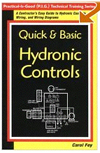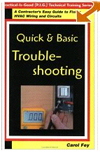by Carol Fey
Don’t fear the meter — it’s an essential tool.A multimeter is
an essential tool for working with controls. It’s as expected
for a professional heating guy to have a meter as it is for
a doctor to have a stethoscope. Digital electronic meters are
very different from the old-fashioned analog items that were
expensive, fragile and hard to read. For under $50, you can
get a nice digital meter that will let you easily test for AC
voltage and continuity. That’s all you need for basic control
circuit testing.
For a little more money, you can add more features, such as
testing for amperage. And, of course, for a lot more money,
you can add a lot more. But it’s not at all necessary.
Digital electronic meters are fairly durable, certainly more
so than their analog predecessors. Most important, though, digital
meters are easy to read. You get your number right there in
front of you with no guessing.How To Use A Meter
Sometimes we need to use a meter to find out what’s going on
in a circuit. I know there are plenty of old-timers who size
up a circuit by the sensation in their hands or fingers. But
go ahead, be a wimp — use a meter. If nothing else, it’ll save
you a lot of time.
A meter is called a multimeter because it has multiple functions.
With one device you can measure volts (V), amps (A), and ohms
(Ω). Depending upon the meter, you can measure volts and amps
for either alternating current (AC) or direct current (DC).
You select the function you need.
In control circuits we primarily use alternating current. These
functions will be marked either AC or ~ (the AC squiggle)Voltage
Voltage is indicated by the letter “V” on the meter. We call
the voltage part of the meter a voltmeter. Set your meter for
the highest possible AC voltage setting. You may think you know
what voltage to expect, but using the highest setting protects
the meter. After the meter tells you what the voltage is, you
can move down to the range that the voltage falls into.
On your meter you’ll find two leads or probes. One is black
and one is red. For our purposes it doesn’t matter which you
put where. Make absolutely certain that your fingers touch only
the colored, insulated part of the probes. You can get shocked
if you let your fingers stray onto the metal tips.
If you’re new to using a meter, or if you’re using a meter you
don’t know well, begin by measuring things you already know;
for example, a house wall outlet.
Often we’re most interested in confirming that there simply
is voltage (Yep, we got power!) rather than exactly how much.
To check for line voltage coming into an electrical outlet,
put one lead in each slot.
The voltage you find in the outlet should be something around
120 volts. The actual voltage delivered by the utility can vary
depending on time of day, time of year, or location. When there
is a greater overall demand (e.g., during high air-conditioning
demand), your voltage may be lower.
When checking a transformer, we want to know whether or not
there is approximately 24V coming out on the secondary side.
If there isn’t, then we would check the primary side of the
transformer for voltage going into it.
As the voltage going into your transformer primary side goes
up or down, so does the voltage coming out of your transformer
secondary.Continuity (Resistance)
Perhaps you’ve watched your buddies take a meter from the case,
touch the two probes together, and make the meter beep. The
beep is the meter’s way of saying, “I found a path to send out
electricity and get it back.” This is called continuity.
The purpose of a continuity check is to confirm that there’s
a path for electricity to follow. It can be critical to know
if there’s a break in a wire, or in the winding of a motor.
The continuity check can also confirm that a switch is closed,
or that a load is good.
To check continuity, put the meter on the continuity setting,
or set it for ohms (Ω), which measures resistance. The Greek
omega symbol is used because the letter “O” (for ohms) looks
too much like a zero.
Before taking any measurements for continuity or resistance,
you must remove all power from the circuit. That’s because the
battery inside the meter supplies the power for these functions.
If you have other power in the circuit, you can damage the meter.Amperage
We use the ammeter meter function less often in troubleshooting.
A multimeter that will test AC (not DC) for amperage costs a
bit more, especially the clamp model. But read on and you may
find it worth the money.
We use the ammeter to determine the amp draw of the circuit
after the circuit has been running a few minutes. For example,
we use this measurement to set the thermostat anticipator for
ideal room comfort. (Match the anticipator to the amp reading
for the industry standard six heating cycles per hour.)
Every load has an amp draw, or amp rating. You can find the
amp rating printed on a load itself, on its box and in the product
data sheet. Finding the amp draw of a circuit can be as simple
as adding the amp ratings of all the parallel loads. But if
you don’t know what all the loads in a circuit are, you need
an ammeter to find out.
To isolate a problem load, you can allow only one load to come
on at a time to see which load is overdrawing the circuit —
for example, the burner, the fan or the humidifier.
In controls work you can expect the amp draw to be in tenths
of an amp. It’s easiest to use a digital meter that measures
in decimals. And the lock feature is a blessing. You can lock
the reading from a hard-to-see place and bring it back to where
you can read it.
There are two ways to measure amps with a meter. The easiest
is to use a meter with a clamp either built-on, or as an attachment.
Place the clamp around any wire in the circuit to get the amp
reading. Make sure it’s just one wire.
If your meter doesn’t have a clamp, you must place it in series
with the circuit. That means you must break the circuit and
put the ammeter in it.
Sometimes the easy way to get the ammeter in series is to place
the probes on the terminals of a switch, such as the thermostat.
The ammeter there will have the effect of closing the switch.
If your meter won’t measure tenths of an amp, make a coil of
10 turns of a piece of normal thermostat wire. Put the clamp
portion of the meter through the coil. Put the ends of the coil
in series with the circuit. Divide the meter reading by 10 to
get your final circuit amp draw.
There’s just no excuse not to have a meter. If your level of
investment has to be in the $10 range, there’s something for
you. You can buy a cheap nondigital (analog) meter at your neighborhood
electronics store. It’s relatively fragile and is harder to
read, but it’ll give you voltage and resistance (continuity)
readings. And that’s really all you need to get started troubleshooting. |




